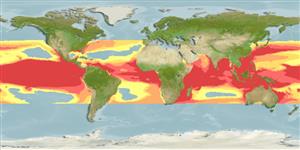Common names from other countries
>
Carangiformes (Jacks) >
Carangidae (Jacks and pompanos) > Caranginae
Etymology: Uraspis: Greek, oura = tail + Greek, aspis = shield (Ref. 45335).
More on author: Poey.
Environment: milieu / climate zone / depth range / distribution range
Ecologia
marinhas; oceanódromo (Ref. 51243); intervalo de profundidade 1 - 50 m (Ref. 89972), usually 2 - 15 m (Ref. 40849). Subtropical; 42°N - 34°S, 180°W - 180°E
Worldwide in warm waters. Western Indian Ocean: Tanzania (Ref. 3287, 3197). Eastern Central Pacific: California, USA to Costa Rica (Ref. 2850). Also in Hawaii. Western Atlantic: Massachusetts, USA and northern Gulf of Mexico to Brazil. Eastern Atlantic: Mauritania to Angola (Ref. 7097); also Algoa Bay, South Africa (Ref. 3197).
Tamanho / Peso / Idade
Maturity: Lm ? range ? - ? cm
Max length : 50.0 cm TL macho/indeterminado; (Ref. 7251); common length : 40.0 cm TL macho/indeterminado; (Ref. 26999); peso máx. publicado: 2.0 kg (Ref. 40637)
Espinhos dorsais (total) : 9; Raios dorsais (total) : 27 - 32; Espinhos anais: 3; Raios anais : 19 - 23. Adults dark to bluish black; juveniles with 6-7 dark bands with pale interspaces (Ref. 3197).
Adults are mostly oceanic and pelagic but sometimes found near the bottom, often near islands. Solitary or in small schools (Ref. 2850).
Ciclo de vida ou comportamento de acasalamento
Maturities | Reprodução | Spawnings | Egg(s) | Fecundities | Larvas
Smith-Vaniz, W.F., J.-C. Quéro and M. Desoutter, 1990. Carangidae. p. 729-755. In J.C. Quero, J.C. Hureau, C. Karrer, A. Post and L. Saldanha (eds.) Check-list of the fishes of the eastern tropical Atlantic (CLOFETA). JNICT, Lisbon; SEI, Paris; and UNESCO, Paris. Vol. 2. (Ref. 7097)
Status na Lista Vermelha da UICN (Ref. 130435)
CITES (Ref. 128078)
Not Evaluated
Ameaça para os humanos
Harmless
Uso pelos humanos
Pescarias: pouco comercial; peixe esportivo: sim
Ferramentas
Relatórios especiais
Baixar XML
Fontes da internet
Estimates based on models
Preferred temperature (Ref.
115969): 20.9 - 29.1, mean 27.2 (based on 41503 cells).
Índice de diversidade filogenética (Ref.
82804): PD
50 = 0.6250 [Uniqueness, from 0.5 = low to 2.0 = high].
Bayesian length-weight: a=0.01349 (0.00646 - 0.02815), b=2.96 (2.79 - 3.13), in cm Total Length, based on LWR estimates for this (Sub)family-body shape (Ref.
93245).
Nível Trófico (Ref.
69278): 4.0 ±0.5 se; based on size and trophs of closest relatives
Resiliência (Ref.
120179): médio(a), tempo mínimo de duplicação da população 1,4 - 4,4 anos (Preliminary K or Fecundity.).
Fishing Vulnerability (Ref.
59153): Moderate vulnerability (40 of 100).
